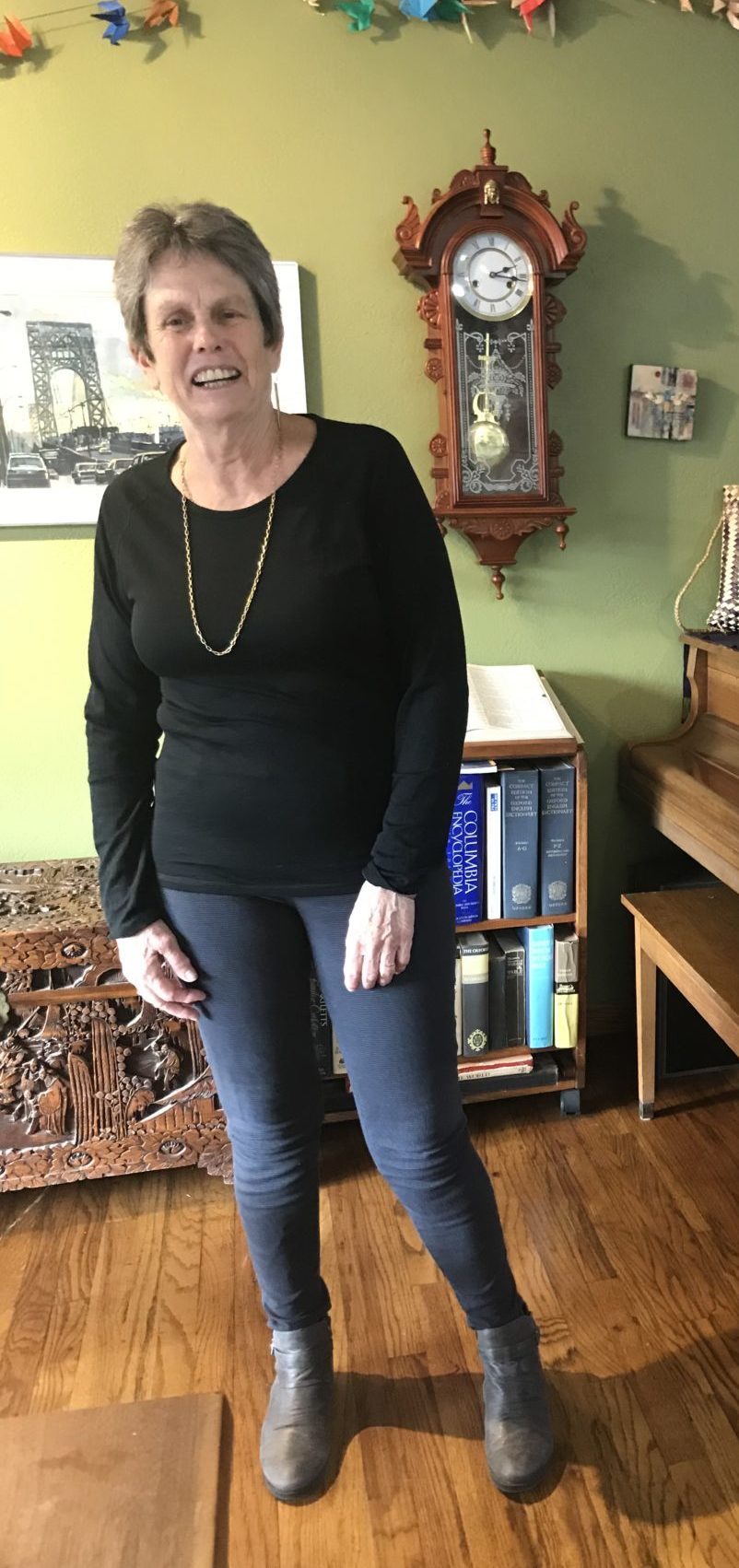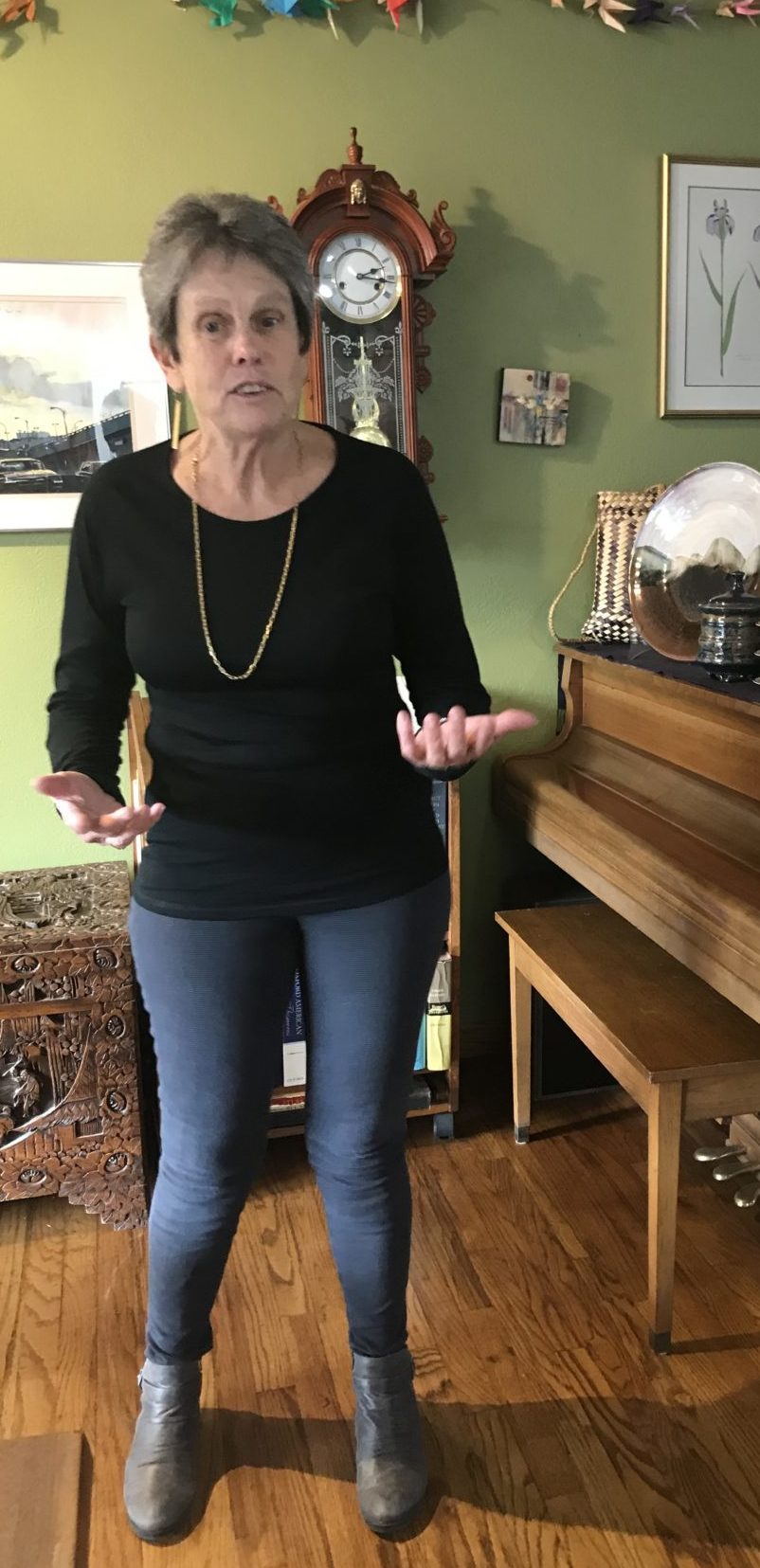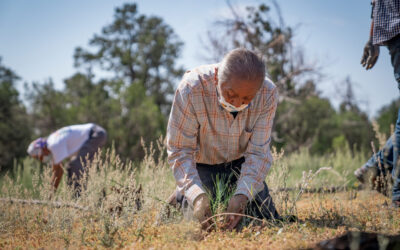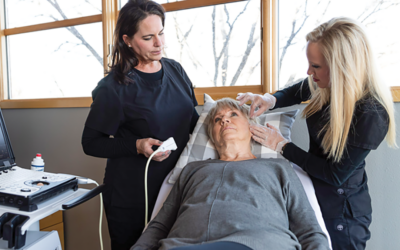A Conversation With Sue Ballou
Sue Ballou is co-chair of the Larimer County Partnership for Age-Friendly Communities’ Housing Priority Group. She is also a member of PAFC’s board of directors. This is a lightly edited excerpt of our conversation. Go to www.pafclarimer.org/housing-1 to learn about PAFC’s housing initiatives.
The Partnership for Age-Friendly Communities started as kind of a partnership between the Foundation on Aging, which has been around for quite a while, and the Larimer County Office on Aging. They wanted to do more than either had been able to do on their own.
What time frame are we talking ?
This was . . . . 2012? Around then. In 2013 we really started forming teams. So we held a stakeholders’ meeting that brought together some 60 people from the community to talk about issues on aging. And out of that we formed four priority groups: Housing, Health and Wellness, Culture of Aging, and Mobility and Access or transportation. And so on each of those priority groups, there are people who work in that field.
I’m co-chair of Housing, and there are people from both housing authorities, there’s a developer, there’s somebody representing the Northern Colorado Builders’ Association, realtors, government people. Each of the four priority groups has those, and then we have a steering committee and a board. It’s 70-some people volunteering their time or coming from their organizations, and one executive director.
Was there something happening around 2012 that spurred the County Office on Aging and the Foundation on Aging to come together and say, “Looking ahead, we see challenges that we don’t feel equipped to deal with effectively on our own” ?
Were there specific things happening that provided an impetus for that union?

So almost doubling in a 20-year period.
They used to call it a tsunami. We don’t call it a tsunami anymore, we call it a golden opportunity. Because it’s not all bad. We older folks have a lot of experience, we have a lot to offer, many of us have money that helps to impel the economy. So there’s a lot of good stuff as well as just people getting old.
When you convened the stakeholder groups, and let’s just specifically talk about housing — what did you hear from different sectors in the community? This is back in 2012, 2013. What were the concerns, opportunities, wants, dislikes —- what kind of feedback were people providing you with?
I think the main thing that came up across the board was an increased desire for choices. For different choices in everything — in housing, in wellness, in activities, in employment. Just not being pigeonholed and being put into one way that you’re supposed to age. And also that what works for people who are older adults works for everybody in a lot of ways. If you make curb cuts and street crossings, they may work for someone pushing a walker, but they also work for someone who’s pushing a stroller. They may work for an older person who takes a little longer to get across the street, and they also work for a toddler. So there’s a lot of crossover in what makes this a more liveable community for everyone.
When people said they wanted more choice, did they feel they were being pigeonholed into a progression where you leave your house and downsize to a patio apartment, and then you go to the nursing home and you’re out of sight and out of mind and out of the community?
It was maybe not quite as bleak as that.
Forgive me.
The standard thing is that people want to age in place. I like to talk about aging in community. Because really the things that are important are being able to see the people you care about, shop at the places you like to shop, have the services you like to have. So it doesn’t necessarily mean staying in the same house. I live in a bi-level. At some point that probably won’t be great. But it does mean being able to access all the stuff that you have always enjoyed. And maybe even other things.

So one of the things that we’re working on that, again, is lifelong: We’re working with the Institute for the Built Environment at Colorado State University to develop a Lifelong Housing Certification, which would be something that developers and builders and realtors could use — and consumers — to find housing. It would be accessible housing — so if possible zero-step entries, wider doors, some of the things that just make sense — but, again, would work for all ages. Lifelong housing. When we were first starting with process, a young woman who was involved said, “I just bought a house and it never occurred to me, there’s 14 steps to get up to the house. What if I have a baby — what am I going to do with a stroller ?!”
Is the Lifelong Housing Certification akin to a LEED sort of thing?
Exactly.
What are the criteria? Or are they still being developed?
They’re still being developed. We’re researching it, we’re trying to find more funding to pull it about. It is becoming a trend. There are a lot of people across the country who are looking at it. But we started a little bit ahead of that wave.
So there’s not a national body at this point. There’s local organizations in various places?
There are a number of organizations that are pulling together, and Institute for the Built Environment is part of that. So we’re partnering with them. They have the expertise. They’re very active in LEED — as you say, LEED’s a great example. And so this would be a similar kind of thing where you could maybe get different levels of certification. And we’re hoping to pilot it in Larimer County and maybe other parts of Colorado and then take it statewide and nationwide.
What has the response been from architects and home builders, interior designers, and so forth?
We did a charette early on to bring together all those people. And they were very excited about it in general. At this point it’s frankly slowed down a little bit because of funding issues. If anybody wants to give us $100,000 or $300,000, that would help. (laughs) We’re about to have another meeting with developers and get input from them.
Do you have a feel for why Fort Collins is ahead of the curve by a few steps? Why here?
It’s because of the Partnership for Age Friendly Communities. When you bring people together who are all looking at housing and aging from different perspectives, and it’s part of what they do, you can break down barriers and come up with great ideas. We have people who run skilled nursing and assisted living places who are saying, “Hey, this would be useful.” So I think it’s really that coalition.
So in other words: People got organized in a way that’s more comprehensive, more interactive than perhaps in other communities.
Yes. There also are many other things that we’re looking at in housing. Some people are interested in co-housing. We’ve started a shared-housing program in Larimer County, Home Share, that is now managed by a local nonprofit. If you’re 55 and older and you have extra space in your house that you’d like to rent out for income, maybe for a little bit of services — not health care, but somebody to mow the lawn — they will help make a match that’s a good match for both the home seeker and the homeowner. Home seekers get to save money, homeowners get to earn a little money.
Who is the broker there?
Neighbor to Neighbor, which is a nonprofit that works in housing issues in Larimer County.
So it’s an independent 501c3.
Yes.
Why them, and not PAFC?
PAFC incubates programs. We try to be a thought leader in aging issues. So we come up with a lot of ideas and we research them and we get them going, but at this point at least we are not at a place to run programs. Because what happens is that then you go down that alley and all the other stuff has to go on the back burner. So we checked out a bunch of nonprofits, and Neighbor to Neighbor agreed to take over this program. They’ve been running it for about a year. And it’s pretty exciting. So that’s just one option. Choices.
What are some of the other things besides housing that have to be addressed to make aging in community feasible?
One of the things PAFC does, we do travel trainings. Through the Mobility and Access Committee, we teach people how to get around on public transportation within various cities and between various cities along the Front Range. Recently they did one with Bustang, so people in Fort Collins got to Bustang by public transportation in Loveland, and in Berthoud, and then they all went down to Denver, had lunch, did some things, and all came back. So that kind of thing is one thing.
The other thing that we’re doing, Larimer County sponsored a study on rural transportation a couple years ago. And the Partnership for Age Friendly Communities was an advisory committee for that. And out of that we applied for and have gotten some fairly large grants to study a rural transportation system. So it would be a one-call type of system — for instance, “I have to get from Red Feather Lakes, which is up in the mountains, to a doctor’s appointment in Loveland. How do I do that?” And the system would figure something out. It may be that you have to get a ride or an Uber to somehere, but then you can catch a bus, and then you can transfer to something else. And so we’re now exploring ways to figure out how to get people where they need to be.
If that service came online, would it be provided by the county?
We’re not sure who it would be provided by. At this point the MPO is partnering with us to work on that. And that’s part of the challenge, to find who would do that in the long run.
What are some of the other housing options that people are looking at ? We’ve talked before about affordability being a major hurdle. Talk to me about what the partnership is doing in that area.
We haven’t really—except for HomeShare, which helps somewhat with that—been able to do as much on affordability, we’re just trying to look at some options. Affordability is an issue in Fort Collins, and I think in a lot of Front Range communities, for all ages. It’s just such a tight housing market. But one of the issues that we’re trying to figure out how to address, and it’s huge, is the assisted living piece. If you’re on Medicaid, you can likely get a nursing home bed. But there aren’t that many assisted living beds for people that are within [financial] reach for most people. So are there ways to address that? Because people will be fine in an apartment, but then either the rent goes up to a point where they can’t afford, it or it’s a second-story apartment and they fall and break a hip. So we’re exploring different ways to address those kinds of issues, because that time between when you get to live wherever you want to live and you don’t have a whole lot of choice, that time is a difficult one to navigate affordably.
I gather that what you’re telling me is that the rapid increase in over-60 population has —- the housing market has lagged the growth.
There are a lot of people who are building assisted living facilities. It’s the affordability piece that’s the problem. If you have the money, there are plenty of lovely places.
So that part of the market is taken care of.
Yes, I think largely. And I think that supply and demand is keeping up. Because that can be a relatively profitable business.
So if you’re at the lower end of the market and you can’t afford to get into one of these nicer places, what are your options? Where do people go?
They try to find Section 8 housing. There are some places — they aren’t assisted living, but they’re independent living places, that are around. Oak Ridge Crossing is one that’s here in Fort Collins that’s income-specific. And there are a few of those places, and I’m not, I don’t know all of them that are available.
Loveland Housing Authority built a fabulous community which is all-income, Mirasol, which has patio homes, apartments, and even the first Green House homes in Colorado, which are skilled nursing but at a very personal level. Really excellent. Green House homes were designed by a guy named Bill Thomas, and it’s a national thing. But there are only two in Colorado. The first was in Loveland. There are 10 people in a house, the house is all one floor, each person has their own room, there’s a communal living room and dining room, there’s a very high ratio of staff to residents, and the staff are very well trained. The residents can be as involved as they want. If they want to help cook dinner, they can. They get to help pick the menu, they get to bring their own recipes. There’s outdoor gardening boxes, there’s a patio with a barbecue. It’s like home. They can bring their pets. It’s very cool.
And it’s owned by the city?
It’s owned by the Loveland Housing Authority.
So now you’ve told me two things that are incubating in this region. The Green House homes and the Lifelong Home Certification. So again, I have to ask you: Why here? Why is this part of Colorado pioneering some of these types of approaches rather than other parts of the state?
As I learn more about nonprofits, I’ve heard over and over again that Northern Colorado has a very cooperative air about it. There’s a limited number of dollars, so there’s competition among nonprofits for funding, but more than perhaps Denver, nonprofits tend to work together here. And certainly we’re going out of our way to work together. The innovations at Mirasol — Loveland Housing Authority’s executive director just retired after 35 years or something, Sam Betters, and he’s just an innovator. He’s on [PAFC’s] housing committee — hooray! — and our board, and he’s very thoughtful. I don’t think it was just him, but he and his team really have been innovative. They also built a whole studio artist place, which I think is the first housing-authority sponsored place like that in the country.
Colorado Springs and Larimer County keep coming up as the two [areas] that are doing cutting-edge stuff. But we’re following two different kinds of models. Colorado Springs got a large grant and has a staff of two and a half people, and they pulled together a bunch of people to get a bunch of ideas, and now they’re kind of chunking through those things as I understand it. We, on the other hand, started with no money. Our executive director, luckily, is starting to raise some. But we started really with no money, just a lot of people who came together and said “Let’s get this done.” So it’s just two different ways to do that, and I think both are committed and willing to move forward. That’s a lot of it, is having people who are saying, “This is what we’re going to do.”
When we look at the growth in the over-60 population in Northern Colorado, do we know how much of that is natural aging of people who’ve lived here throughout that 20-year period [ie 2000-2020], as opposed to people who are moving here to retire — choosing to age in this community as opposed to wherever they came from?
Last I talked to the state demographer, it is largely people aging here naturally. There are certainly people who move here — my parents moved here for the last 10 years of their lives. And I think that happens, people move here to be by their kids. But people also leave here to be by their kids somewhere else. I think a lot of people chose this community a long time ago, or have been choosing it over time, and are just choosing to age here.
I wonder if the aging options become attractive here, if you’re successful in providing a lot of different options, will this become sort of a retirement destination ?
It’s possible. Several years ago we were listed as one of the top communities in which to retire. So certainly those kinds of things do attract people. And there are some nice communities that are being developed that are specifically for people 55 and up. So there are several developments being built, both apartments and single-family homes and patio homes, all of those things. And a lot of that is market driven, which makes sense. I think anybody moving here faces the same housing challenges as anybody else. It’s a tight market. If it’s available and you can afford it, fabulous.
One of the members of our Housing Priority Group, Bill Swalling, is developing Water’s Edge, north of Fort Collins. I think he is really aiming at the population who lives here, thinking that they will move there as an active community. And one of the thoughts behind that is that they leave houses that families can move into. So that is part of going from “aging in place” to an “aging in community” theory. Ideally, I will eventually free up my fairly large house for two people and a young family can move into it.
So over the six or seven years that you’ve been focusing on this, are there things that worry you? Challenges that you see on the horizon that you’re still not sure how you’re going to solve it?
Sam Betters said, “Housing is one of the few things that if you had enough money, you could solve it for everybody.” It’s not like cancer, it’s not like war. I do think the disparities for all ages, but probably harder for the aging, is having a safe and comfortable place to live for everybody. There’s a large homeless population, and how we deal with that and how we keep people who just can’t live on the streets from doing that, I have no solutions there at all. It’s easier and in some ways more fun to address the [issue of providing] choices for everybody. I know a number of women, particularly single women, who — I was just talking to somebody last night who said she doesn’t have nearly the retirement that her male counterparts have, because she didn’t get paid as much because we have that wage gap. A statistic that I read — it’s worse for women than for men — but across the board, something like 40 percent of people over 55 have less than $50,000 saved. That’s pretty frightening. And that then becomes a national problem, because what are we going to do if we have all these people who can’t afford to live anywhere?





